人教版九年级下册 Unit14 名词 课件(共28张PPT)
文档属性
| 名称 | 人教版九年级下册 Unit14 名词 课件(共28张PPT) |  | |
| 格式 | ppt | ||
| 文件大小 | 14.5MB | ||
| 资源类型 | 教案 | ||
| 版本资源 | 人教新目标(Go for it)版 | ||
| 科目 | 英语 | ||
| 更新时间 | 2023-03-17 21:46:24 | ||
图片预览


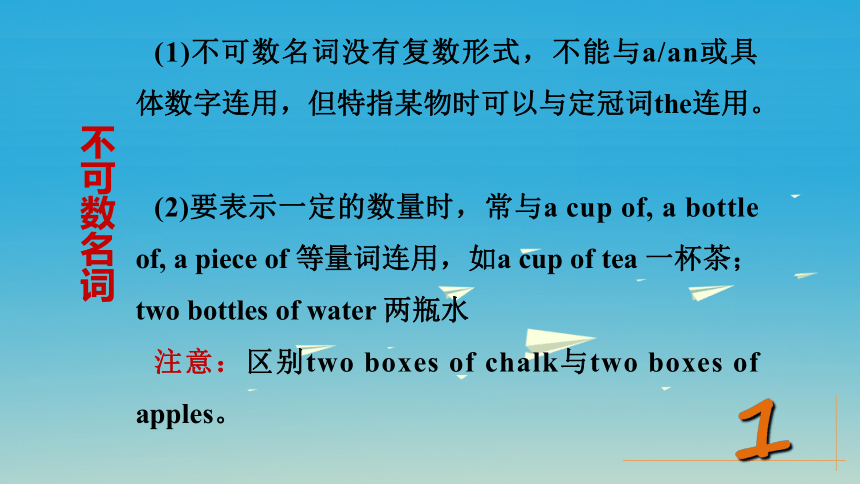
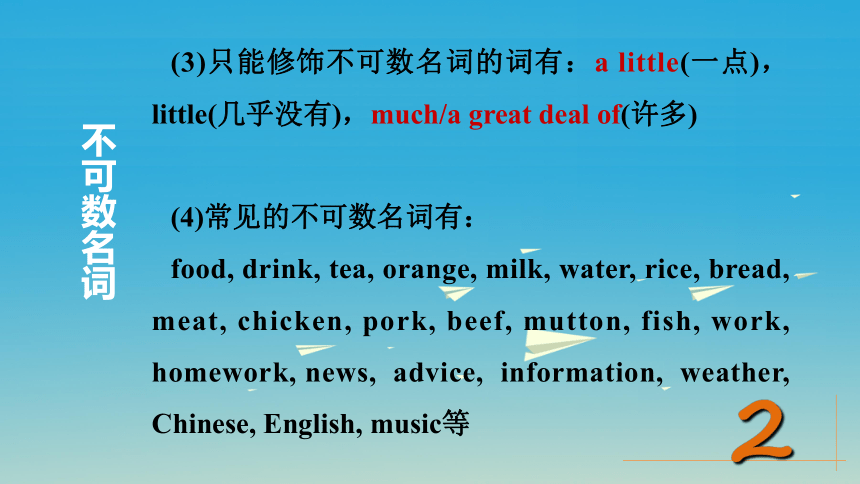
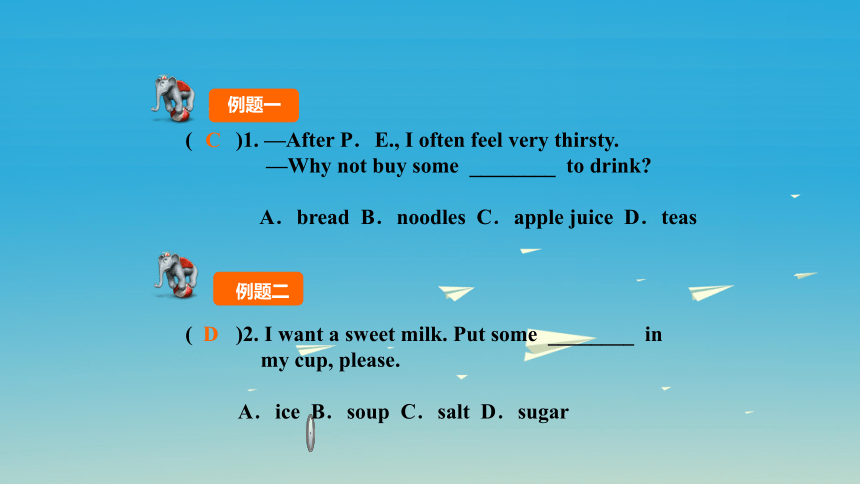

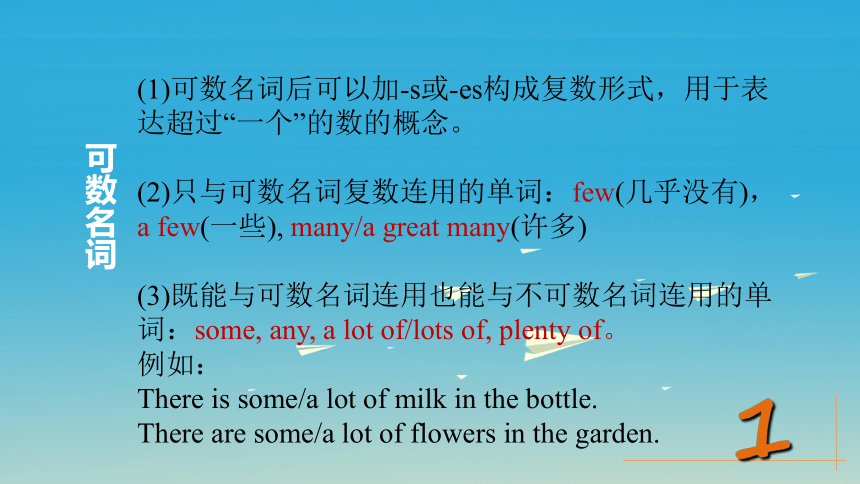
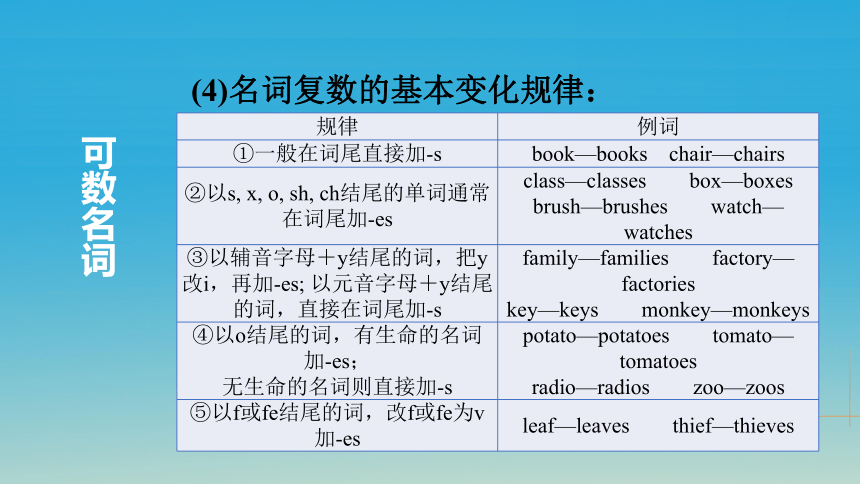
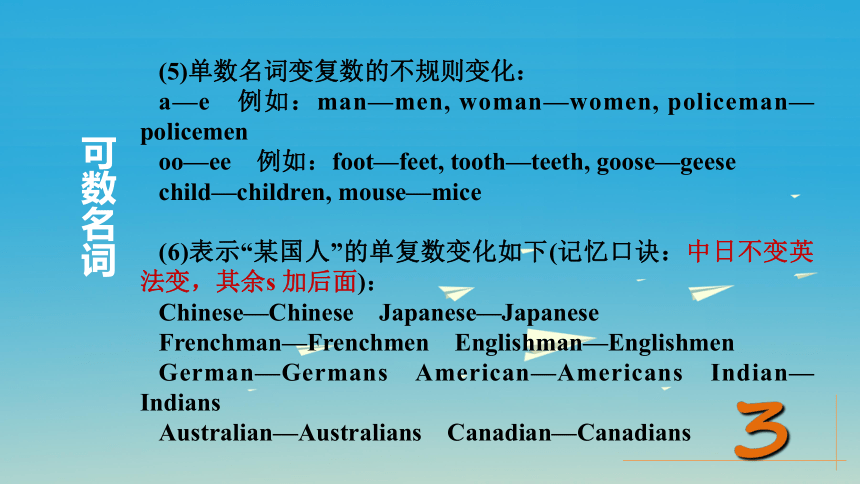
文档简介
(共28张PPT)
名词
考点一 不可数名词
1
不可数名词
(1)不可数名词没有复数形式,不能与a/an或具体数字连用,但特指某物时可以与定冠词the连用。
(2)要表示一定的数量时,常与a cup of, a bottle of, a piece of 等量词连用,如a cup of tea 一杯茶; two bottles of water 两瓶水
注意:区别two boxes of chalk与two boxes of apples。
2
不可数名词
(3)只能修饰不可数名词的词有:a little(一点),little(几乎没有),much/a great deal of(许多)
(4)常见的不可数名词有:
food, drink, tea, orange, milk, water, rice, bread, meat, chicken, pork, beef, mutton, fish, work, homework, news, advice, information, weather, Chinese, English, music等
互动一
例题一
( )1. —After P.E., I often feel very thirsty.
—Why not buy some ________ to drink
A.bread B.noodles C.apple juice D.teas
( )2. I want a sweet milk. Put some ________ in
my cup, please.
A.ice B.soup C.salt D.sugar
例题二
D
C
考点二 可数名词
可数名词
1
(1)可数名词后可以加 s或 es构成复数形式,用于表达超过“一个”的数的概念。
(2)只与可数名词复数连用的单词:few(几乎没有),a few(一些), many/a great many(许多)
(3)既能与可数名词连用也能与不可数名词连用的单词:some, any, a lot of/lots of, plenty of。
例如:
There is some/a lot of milk in the bottle.
There are some/a lot of flowers in the garden.
可数名词
2
(4)名词复数的基本变化规律:
规律 例词
①一般在词尾直接加 s book—books chair—chairs
②以s, x, o, sh, ch结尾的单词通常在词尾加 es class—classes box—boxes
brush—brushes watch—watches
③以辅音字母+y结尾的词,把y改i,再加 es; 以元音字母+y结尾的词,直接在词尾加 s family—families factory—factories
key—keys monkey—monkeys
④以o结尾的词,有生命的名词加 es;
无生命的名词则直接加 s potato—potatoes tomato—tomatoes
radio—radios zoo—zoos
⑤以f或fe结尾的词,改f或fe为v加 es leaf—leaves thief—thieves
可数名词
3
(5)单数名词变复数的不规则变化:
a—e 例如:man—men, woman—women, policeman—policemen
oo—ee 例如:foot—feet, tooth—teeth, goose—geese
child—children, mouse—mice
(6)表示“某国人”的单复数变化如下(记忆口诀:中日不变英法变,其余s 加后面):
Chinese—Chinese Japanese—Japanese
Frenchman—Frenchmen Englishman—Englishmen
German—Germans American—Americans Indian—Indians
Australian—Australians Canadian—Canadians
可数名词
5
(7)有的名词只有复数形式,通常是人们身上穿的、戴的、用的。例如:people, police, clothes, trousers, pants, jeans, scissors, shorts。
(8)常见的单复数同形的名词有:Chinese, Japanese, sheep, deer, fish。例如:
a Chinese—two Chinese a sheep—many sheep
可数名词
4
(9)由两个名词组成的名词词组,通常只变后面一个名词为复数。
例如:
an apple tree—two apple trees
a girl student—many girl students
a shoe shop—a few shoe shops
但如果前面名词是man或woman时,则两个名词都要变成复数。例如:
a man teacher—some men teachers
a woman doctor—ten women doctors
互动一
例题一
例题二
B
B
( )1. When Peter comes, please ask him to leave a ________.
A.notice B.message C.sentence D.information
( )2. If you work harder, you'll have another ________
to play the violin at a concert.
A.sleep B.Chance C.mistake D.problem
考点三 名词所有格
名词所有格
(1)'s所有格:表示有生命名词的所有格
①不以s结尾名词的所有格,直接在词尾加's。例如:Kate's bag, my friend's bike, Children's Day, Women's Day
②以s结尾的复数名词的所有格,在词尾加'。例如:Teachers' Day, students' books
③表示两人共同拥有的人或物,在后一个人名后加's。例如:Lucy and Lily's mother
④表示两人分别拥有的人或物,则两个人名后都要加's。例如:Tom's and Jim's books
⑤表示店铺、住宅、公共建筑等地名时,所有格后面的名词常常省略。例如:at the doctor's
⑥双重所有格:用's所有格与of 所有格相结合。例如:a friend of my father's a book of mine
1
名词所有格
(2) of 所有格: 表示无生命名词的所有格。例如:the door of the room, the color of the clothes。但是有些表示时间、距离、重量、价值、国家和城市等无生命的名词,也可加's构成所有格。
例如:today‘s newspaper
eight days' holiday=an 8 day holiday
five minutes' walk=a five minute walk
2
互动一
例题一
例题二
B
A
( )1. —How far is it from Tianjin to Changsha
—It is a ________ flight from Tianjin to Changsha.
A.2 hour long B.2 hours long C.2 hours' long D.2 hour long
( )2. A friend of my ________ and I are going to visit ________ next week.
A.father; Browns B.father's; the Browns
C.father; the Browns D.father's; Browns
sound
voice
noise
①sound 表示“声音”,指耳朵能听到的各种声音。
例如:
I heard the sound of the bell.
②voice 表示“声音”,主要指人的声音。
例如:
She has a beautiful voice.
③noise 指“噪音”。词组有:make a noise等。
1.The ________ made me feel annoyed. I want to be in a quiet place.
2.The teacher said in a loud ________,“Please keep silent.”
3.At the foot of the hill you could hear nothing but the ________ of the running water.
sound
voice
noise
job
work
① job “工作”,是可数名词。
②work “工作”,可以作名词或动词;作名词表示“工作”时是不可数的;作名词表示“著作”时是可数的。
1.He has lost three ________, because he doesn't ________ hard.
2.Do you want to ________ late We will have a ________ for you as a waiter.
jobs
work
job
work
a number of
the number of
①a number of 表示“大量的;许多”,谓语动词用复数。
例如:
A number of persons are playing chess.
②the number of 表示“……的数量”,谓语动词用单数。
例如:
The number of people in the room is 50.
1.____________ foreign students are studying in this college.
2.____________ American students is over 30.
A number of
The number of
idea
advice
①idea 表示“主意”,是可数名词。
例如:a good idea。
②advice表示“建议;忠告”,是不可数名词。
例如:a piece of advice。
1. Can you give me some ________ on how to learn English well
2.He has got a good ________ to deal with his old books.
idea
advice
news
information
message
①news 表示“新闻;消息”,是不可数名词。例如:two pieces of news.
②information 表示“信息;资料”,侧重信息的价值,是不可数名词。
例如: some information
③message 表示“消息;音信”,侧重信息的简短,是可数名词。 常用词组:leave a message(留言); give a message to…(捎口信给……)
instruction
④instruction 表示“说明;须知;教导”,是可数名词。
例如:some instructions
1. What bad ________! The school trip will be put off because of the sports
meeting.
2.—I don't know how to use this machine.
—It doesn't matter. Here is the ____________.
3.Would you please give a __________ to Li Lei He is not at school.
4.Can you provide me with some ____________ about the trip
news
information
message
instruction
house
family
home
①house 表示“住宅”,指的是具体的房子或建筑物。
②family 表示“家;家庭”,也可指全体家庭成员。
③home 意为“家”,带有眷恋等感彩。
1. I bought a new ________ in Zhongshan.
2.Tom has a big ________. There are six people in his ________.
3.She has been in Shenzhen for 10 years. Shenzhen has become her second ________.
house
family
home
family
名词
考点一 不可数名词
1
不可数名词
(1)不可数名词没有复数形式,不能与a/an或具体数字连用,但特指某物时可以与定冠词the连用。
(2)要表示一定的数量时,常与a cup of, a bottle of, a piece of 等量词连用,如a cup of tea 一杯茶; two bottles of water 两瓶水
注意:区别two boxes of chalk与two boxes of apples。
2
不可数名词
(3)只能修饰不可数名词的词有:a little(一点),little(几乎没有),much/a great deal of(许多)
(4)常见的不可数名词有:
food, drink, tea, orange, milk, water, rice, bread, meat, chicken, pork, beef, mutton, fish, work, homework, news, advice, information, weather, Chinese, English, music等
互动一
例题一
( )1. —After P.E., I often feel very thirsty.
—Why not buy some ________ to drink
A.bread B.noodles C.apple juice D.teas
( )2. I want a sweet milk. Put some ________ in
my cup, please.
A.ice B.soup C.salt D.sugar
例题二
D
C
考点二 可数名词
可数名词
1
(1)可数名词后可以加 s或 es构成复数形式,用于表达超过“一个”的数的概念。
(2)只与可数名词复数连用的单词:few(几乎没有),a few(一些), many/a great many(许多)
(3)既能与可数名词连用也能与不可数名词连用的单词:some, any, a lot of/lots of, plenty of。
例如:
There is some/a lot of milk in the bottle.
There are some/a lot of flowers in the garden.
可数名词
2
(4)名词复数的基本变化规律:
规律 例词
①一般在词尾直接加 s book—books chair—chairs
②以s, x, o, sh, ch结尾的单词通常在词尾加 es class—classes box—boxes
brush—brushes watch—watches
③以辅音字母+y结尾的词,把y改i,再加 es; 以元音字母+y结尾的词,直接在词尾加 s family—families factory—factories
key—keys monkey—monkeys
④以o结尾的词,有生命的名词加 es;
无生命的名词则直接加 s potato—potatoes tomato—tomatoes
radio—radios zoo—zoos
⑤以f或fe结尾的词,改f或fe为v加 es leaf—leaves thief—thieves
可数名词
3
(5)单数名词变复数的不规则变化:
a—e 例如:man—men, woman—women, policeman—policemen
oo—ee 例如:foot—feet, tooth—teeth, goose—geese
child—children, mouse—mice
(6)表示“某国人”的单复数变化如下(记忆口诀:中日不变英法变,其余s 加后面):
Chinese—Chinese Japanese—Japanese
Frenchman—Frenchmen Englishman—Englishmen
German—Germans American—Americans Indian—Indians
Australian—Australians Canadian—Canadians
可数名词
5
(7)有的名词只有复数形式,通常是人们身上穿的、戴的、用的。例如:people, police, clothes, trousers, pants, jeans, scissors, shorts。
(8)常见的单复数同形的名词有:Chinese, Japanese, sheep, deer, fish。例如:
a Chinese—two Chinese a sheep—many sheep
可数名词
4
(9)由两个名词组成的名词词组,通常只变后面一个名词为复数。
例如:
an apple tree—two apple trees
a girl student—many girl students
a shoe shop—a few shoe shops
但如果前面名词是man或woman时,则两个名词都要变成复数。例如:
a man teacher—some men teachers
a woman doctor—ten women doctors
互动一
例题一
例题二
B
B
( )1. When Peter comes, please ask him to leave a ________.
A.notice B.message C.sentence D.information
( )2. If you work harder, you'll have another ________
to play the violin at a concert.
A.sleep B.Chance C.mistake D.problem
考点三 名词所有格
名词所有格
(1)'s所有格:表示有生命名词的所有格
①不以s结尾名词的所有格,直接在词尾加's。例如:Kate's bag, my friend's bike, Children's Day, Women's Day
②以s结尾的复数名词的所有格,在词尾加'。例如:Teachers' Day, students' books
③表示两人共同拥有的人或物,在后一个人名后加's。例如:Lucy and Lily's mother
④表示两人分别拥有的人或物,则两个人名后都要加's。例如:Tom's and Jim's books
⑤表示店铺、住宅、公共建筑等地名时,所有格后面的名词常常省略。例如:at the doctor's
⑥双重所有格:用's所有格与of 所有格相结合。例如:a friend of my father's a book of mine
1
名词所有格
(2) of 所有格: 表示无生命名词的所有格。例如:the door of the room, the color of the clothes。但是有些表示时间、距离、重量、价值、国家和城市等无生命的名词,也可加's构成所有格。
例如:today‘s newspaper
eight days' holiday=an 8 day holiday
five minutes' walk=a five minute walk
2
互动一
例题一
例题二
B
A
( )1. —How far is it from Tianjin to Changsha
—It is a ________ flight from Tianjin to Changsha.
A.2 hour long B.2 hours long C.2 hours' long D.2 hour long
( )2. A friend of my ________ and I are going to visit ________ next week.
A.father; Browns B.father's; the Browns
C.father; the Browns D.father's; Browns
sound
voice
noise
①sound 表示“声音”,指耳朵能听到的各种声音。
例如:
I heard the sound of the bell.
②voice 表示“声音”,主要指人的声音。
例如:
She has a beautiful voice.
③noise 指“噪音”。词组有:make a noise等。
1.The ________ made me feel annoyed. I want to be in a quiet place.
2.The teacher said in a loud ________,“Please keep silent.”
3.At the foot of the hill you could hear nothing but the ________ of the running water.
sound
voice
noise
job
work
① job “工作”,是可数名词。
②work “工作”,可以作名词或动词;作名词表示“工作”时是不可数的;作名词表示“著作”时是可数的。
1.He has lost three ________, because he doesn't ________ hard.
2.Do you want to ________ late We will have a ________ for you as a waiter.
jobs
work
job
work
a number of
the number of
①a number of 表示“大量的;许多”,谓语动词用复数。
例如:
A number of persons are playing chess.
②the number of 表示“……的数量”,谓语动词用单数。
例如:
The number of people in the room is 50.
1.____________ foreign students are studying in this college.
2.____________ American students is over 30.
A number of
The number of
idea
advice
①idea 表示“主意”,是可数名词。
例如:a good idea。
②advice表示“建议;忠告”,是不可数名词。
例如:a piece of advice。
1. Can you give me some ________ on how to learn English well
2.He has got a good ________ to deal with his old books.
idea
advice
news
information
message
①news 表示“新闻;消息”,是不可数名词。例如:two pieces of news.
②information 表示“信息;资料”,侧重信息的价值,是不可数名词。
例如: some information
③message 表示“消息;音信”,侧重信息的简短,是可数名词。 常用词组:leave a message(留言); give a message to…(捎口信给……)
instruction
④instruction 表示“说明;须知;教导”,是可数名词。
例如:some instructions
1. What bad ________! The school trip will be put off because of the sports
meeting.
2.—I don't know how to use this machine.
—It doesn't matter. Here is the ____________.
3.Would you please give a __________ to Li Lei He is not at school.
4.Can you provide me with some ____________ about the trip
news
information
message
instruction
house
family
home
①house 表示“住宅”,指的是具体的房子或建筑物。
②family 表示“家;家庭”,也可指全体家庭成员。
③home 意为“家”,带有眷恋等感彩。
1. I bought a new ________ in Zhongshan.
2.Tom has a big ________. There are six people in his ________.
3.She has been in Shenzhen for 10 years. Shenzhen has become her second ________.
house
family
home
family
同课章节目录
- Unit 1 How can we become good learners.
- Section A
- Section B
- Unit 2 I think that mooncakes are delicious!
- Section A
- Section B
- Unit 3 Could you please tell me where the restroom
- Section A
- Section B
- Unit 4 I used to be afraid of the dark.
- Section A
- Section B
- Unit 5 What are the shirts made of?
- Section A
- Section B
- Review of Units 1-5
- Unit 6 When was it invented?
- Section A
- Section B
- Unit 7 Teenagers should be allowed to choose their
- Section A
- Section B
- Unit 8 It must belong to Carla.
- Section A
- Section B
- Unit 9 I like music that I can dance to.
- Section A
- Section B
- Unit 10 You're supposed to shake hands.
- Section A
- Section B
- Review of Units 6-10
- Unit 11 Sad movies make me cry.
- Section A
- Section B
- Unit 12 Life is full of the unexpected
- Section A
- Section B
- Unit 13 We're trying to save the earth!
- Section A
- Section B
- Unit 14 I remember meeting all of you in Grade 7.
- Section A
- Section B
- Review of Units 11-14
